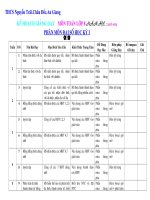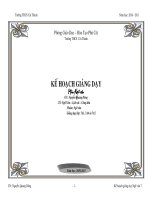- Trang chủ >>
- Sư phạm >>
- Sư phạm hóa
Kế hoạch giảng dạy Tiếng Anh Toán Khoa học lớp 2 chương trình Ismart
Bạn đang xem bản rút gọn của tài liệu. Xem và tải ngay bản đầy đủ của tài liệu tại đây (663.33 KB, 5 trang )
<span class='text_page_counter'>(1)</span><div class='page_container' data-page=1>
1
Science 2 syllabus (v2018)
<b>SCIENCE 2 – SYLLABUS </b>
<b>Syllabus overview: </b>
● 1 introduction
● 17 lessons
● 11 revisions
● 2 Science projects (*)
● 4 progress tests
Total: 35 periods
<b>General objectives for language learning: </b>
● Understand the meaning of vocabulary
● Pronounce all the vocabulary correctly
● Be able to communicate the knowledge in English
● Begin to recognise the spelling
● Use context clues, including pictures and prior knowledge,
to identify words
● Enhance cognitive recognition of words with
pronunciation
● Be able to write in full sentences of structures in the lesson
(Grade 3 and above)
● Apply the structures (in Italic) communicating and writing
(Grade 3 and above)
<b>Guidelines for teachers: </b>
➢ Each lesson must be taught with digital contents and other supportive materials (if available).
</div>
<span class='text_page_counter'>(2)</span><div class='page_container' data-page=2>
2
Science 2 syllabus (v2018)
<b>Week </b> <b>Unit </b> <b>Lesson </b> <b>Learning outcomes </b> <b>Vocabulary and structure(s) </b>
1 <b>Introduction </b>
2
U1 –
Transportation
L1: Means of
transportation
● Visually recognise and label different
means of transportation on the street
● Know that motorbike and bicycle have 2
wheels; others have more than 2 wheels
● Be able to compare the size among these
means of transportation
● <i>What is this? This is ….</i>
● <i>Which is bigger/ longer? … is </i>
<i>bigger/ longer than ...</i>
Motorbike, bicycle, car, bus, truck
3
L2: Means of
transportation
(cont.)
● Visually recognise and label different
means of transportation
● Distinguish whether these means of
transportation travel on land, on water or
in the sky
● <i>What is this? This is ….</i>
● <i>… travel on land/ on water/ in the </i>
<i>sky.</i>
Plane, boat, train, on land, on water, in
the sky
4 Revision of Unit 1
5
U2 –
Musculoskelet
al system
L1: Bones
● Identify the different kinds of bones and
their positions in the skeletal system
● Visually recognise and label the skeleton
● <i>The skull/ rib cage/ spine belongs to </i>
<i>the skeleton. </i>
Skeleton, skull, rib cage, spine, bone
6 L2: Joints and
muscles
● Identify joint and muscle
● Visually recognise and label the given
pictures
● Know that joints and muscles support the
movement of bones so we can do many
activities
● <i>Joints and muscles support </i>
<i>movement </i>
Joint, muscle, movement, support
</div>
<span class='text_page_counter'>(3)</span><div class='page_container' data-page=3>
3
Science 2 syllabus (v2018)
8 <b>Revision for progress test 1 </b>
9 <b>Progress test 1 </b>
10
U3 – Digestive
system
L1: Digestion in
human
● Identify the different digestive organs and
their positions in the digestive system
● Know that digestive system helps us
digest (break down) food.
● Visually recognise and label the digestive
system
● <i>The digestive system helps us digest </i>
<i>food. </i>
Digest, mouth, food pipe, stomach,
digestive system
11 L2: Digestion in
human (cont.)
● <i>The … belongs to the digestive </i>
<i>system. </i>
Small intestine, large intestine, anus
12 Revision of Unit 3
13
U4 – Food and
food groups
L1: Common
foods
● Name some common foods
● Visually recognise and label the different
foods
● Be encouraged to eat a variety of food to
be healthy
● <i>What do you like? I like ... </i>
Egg, milk, rice, grapes, cabbage
14 L2: The basic food
groups
● Know the basic food groups
● Be able to sort the foods into the correct
food groups
● <i>… belongs to fruit/ grain/ vegetable/ </i>
<i>protein/ dairy group.</i>
Fruit, grain, vegetable, protein, dairy
15 <b>Revision for progress test 2 </b>
16 <b>Progress test 2 </b>
17 <b>Science Project 1 </b>
18 U5 – Natural
habitats L1: Land habitats
● Define a habitat
● Visually recognise different kinds of
habitats on land
</div>
<span class='text_page_counter'>(4)</span><div class='page_container' data-page=4>
4
Science 2 syllabus (v2018)
19 L2: Aquatic
habitats
● Visually recognise different kinds of
aquatic habitats
● Differentiate between land and aquatic
habitats by figures
● <i>What habitat is it? It is ….</i>
Pond, ocean, river, swamp
20 Revision of Unit 5
21
U6 – Plants
and their
habitats
L1: Plants living
on land
● Visually recognise and label different
plants that live on land
● Be able to match the plants with their
habitats
● <i>What plant is it? It is ….</i>
● <i>… lives in ....</i>
Grass, pine tree, cactus, fern
22 L2: Aquatic plants
● Visually recognise and label different
kinds of aquatic plants
● Be able to match the plants with their
habitats
● <i>What plant is it? It is ….</i>
● <i>… lives in ...</i>
Lotus, seaweed, waterlily, duckweed
23 L3: Benefits of
plants
● Be able to tell that plants provide us
oxygen, food and shade
● Know that plants also help reduce
pollution
● <i>What do plants provide us? They </i>
<i>provide us … </i>
Oxygen, food, shade, pollution
24 Revision of Unit 6
25 <b>Revision for progress test 3 </b>
26 <b>Progress test 3 </b>
27
U7 – Animals
and their
habitats
L1: Animals
living on land
● Visually recognise and label different
kinds of animals that live on land
● Be able to match the animals with their
</div>
<span class='text_page_counter'>(5)</span><div class='page_container' data-page=5>
5
Science 2 syllabus (v2018)
habitats
28 L2: Aquatic
animals
● Visually recognise and label different
kinds of aquatic animals
● Be able to match the animals with their
habitats
● <i>What animal is it? It is ….</i>
Octopus, seahorse, catfish, goldfish
29 Revision of Unit 7
30
U8 - The Sun
L1: Properties of
the Sun
● Know that the Sun is like a giant fireball
● Recognise the importance of the Sun -
giving us light and heat
● <i>The Sun is like a giant fireball. </i>
● <i>The Sun gives us light and heat. </i>
Fireball, light, heat, bright
31 L2: Sunrise and
Sunset
● Be able to tell that the Sun rises in the East
and sets in the West
● Know that the Sun rises around 6 AM and
sets around 6 PM
● <i>The Sun rises/ sets in the East/ </i>
<i>West. </i>
Sunset, sunrise, West, East
32 Revision of Unit 8
33 <b>Revision for progress test 4 </b>
34 <b>Progress test 4 </b>
</div>
<!--links-->









